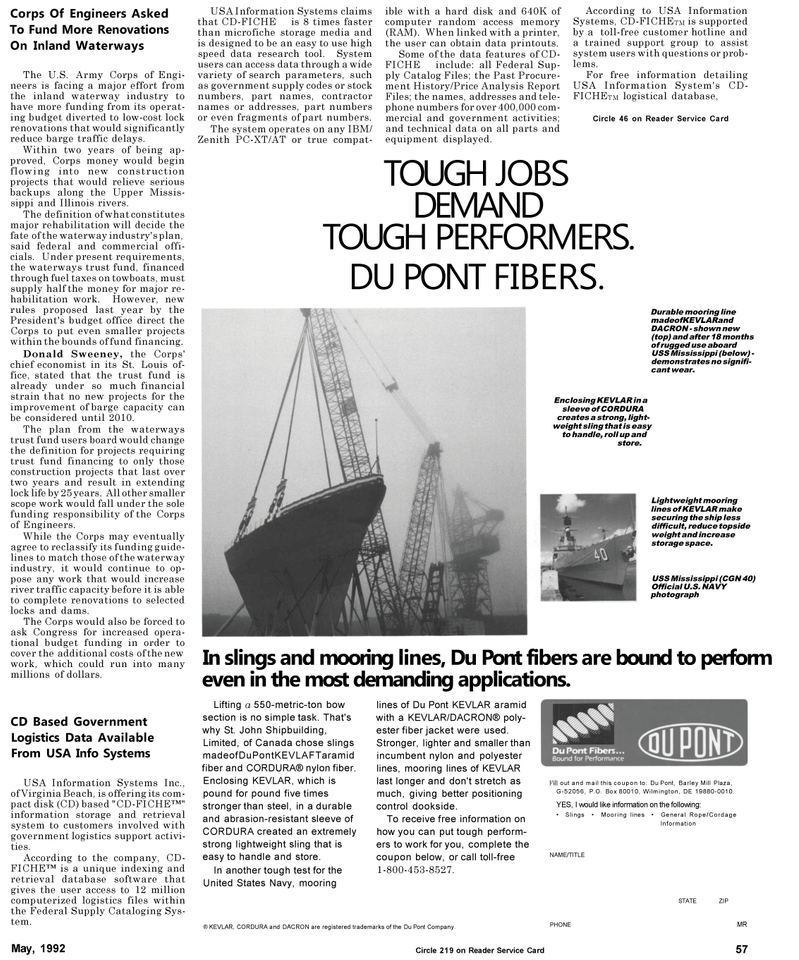
Page 61: of Maritime Reporter Magazine (May 1992)
Read this page in Pdf, Flash or Html5 edition of May 1992 Maritime Reporter Magazine
Corps Of Engineers Asked
To Fund More Renovations
On Inland Waterways
The U.S. Army Corps of Engi- neers is facing a major effort from the inland waterway industry to have more funding from its operat- ing budget diverted to low-cost lock renovations that would significantly reduce barge traffic delays.
Within two years of being ap- proved, Corps money would begin flowing into new construction projects that would relieve serious backups along the Upper Missis- sippi and Illinois rivers.
The definition of what constitutes major rehabilitation will decide the fate of the waterway industry's plan, said federal and commercial offi- cials. Under present requirements, the waterways trust fund, financed through fuel taxes on towboats, must supply half the money for major re- habilitation work. However, new rules proposed last year by the
President's budget office direct the
Corps to put even smaller projects within the bounds of fund financing.
Donald Sweeney, the Corps' chief economist in its St. Louis of- fice, stated that the trust fund is already under so much financial strain that no new projects for the improvement of barge capacity can be considered until 2010.
The plan from the waterways trust fund users board would change the definition for projects requiring trust fund financing to only those construction projects that last over two years and result in extending lock life by 25 years. All other smaller scope work would fall under the sole funding responsibility of the Corps of Engineers.
While the Corps may eventually agree to reclassify its funding guide- lines to match those of the waterway industry, it would continue to op- pose any work that would increase river traffic capacity before it is able to complete renovations to selected locks and dams.
The Corps would also be forced to ask Congress for increased opera- tional budget funding in order to cover the additional costs of the new work, which could run into many millions of dollars.
CD Based Government
Logistics Data Available
From USA Info Systems
USA Information Systems Inc., of Virginia Beach, is offering its com- pact disk (CD) based "CD-FICHE™" information storage and retrieval system to customers involved with government logistics support activi- ties.
According to the company, CD-
FICHE™ is a unique indexing and retrieval database software that gives the user access to 12 million computerized logistics files within the Federal Supply Cataloging Sys- tem.
DU PONT FIBERS.
USA Information Systems claims that CD-FICHE is 8 times faster than microfiche storage media and is designed to be an easy to use high speed data research tool. System users can access data through a wide variety of search parameters, such as government supply codes or stock numbers, part names, contractor names or addresses, part numbers or even fragments of part numbers.
The system operates on any IBM/
Zenith PC-XT/AT or true compat- ible with a hard disk and 640K of computer random access memory (RAM). When linked with a printer, the user can obtain data printouts.
Some of the data features of CD-
FICHE include: all Federal Sup- ply Catalog Files; the Past Procure- ment History/Price Analysis Report
Files; the names, addresses and tele- phone numbers for over 400,000 com- mercial and government activities; and technical data on all parts and equipment displayed.
According to USA Information
Systems, CD-FICHETM is supported by a toll-free customer hotline and a trained support group to assist system users with questions or prob- lems.
For free information detailing
USA Information System's CD-
FICHETM logistical database,
Circle 46 on Reader Service Card
TOUGH JOBS DEMAND
TOUGH PERFORMERS.
Durable mooring line madeofKEVLARand
DACRON - shown new (top) and after 18 months of rugged use aboard
USS Mississippi (below) - demonstrates no signifi- cant wear.
Enclosing KEVLAR in a sleeve of CORDURA creates a strong, light- weight sling that is easy to handle, roll up and store.
Lightweight mooring lines of KEVLAR make securing the ship less difficult, reduce topside weight and increase storage space.
USS Mississippi (CGN 40)
Official U.S. NAVY photograph
In slings and mooring lines, Du Pont fibers are bound to perform even in the most demanding applications.
Lifting a 550-metric-ton bow section is no simple task. That's why St. John Shipbuilding,
Limited, of Canada chose slings madeofDuPontKEVLAFTaramid fiber and CORDURA® nylon fiber.
Enclosing KEVLAR, which is pound for pound five times stronger than steel, in a durable and abrasion-resistant sleeve of
CORDURA created an extremely strong lightweight sling that is easy to handle and store.
In another tough test for the
United States Navy, mooring lines of Du Pont KEVLAR aramid with a KEVLAR/DACRON® poly- ester fiber jacket were used.
Stronger, lighter and smaller than incumbent nylon and polyester lines, mooring lines of KEVLAR last longer and don't stretch as much, giving better positioning control dookside.
To receive free information on how you can put tough perform- ers to work for you, complete the coupon below, or call toll-free 1-800-453-8527. ® KEVLAR, CORDURA and DACRON are registered trademarks of the Du Pont Company.
Fill out and mail this coupon to: Du Pont, Barley Mill Plaza,
G-52056, P.O. Box 80010, Wilmington, DE 19880-0010.
YES, I would like information on the following: • Slings • Mooring lines • General Rope/Cordage
Information
NAME/TITLE
STATE ZIP
PHONE MR
May, 1992 Circle 219 on Reader Service Card 57

 60
60

 62
62
